- Home
- Hermann Hesse
Demian Page 3
Demian Read online
Page 3
At that moment the soldier Sinclair also feels piercing pain as the dream vision turns into reality. "One of these stars shot straight at me with a shriek; it seemed to be trying to find me. . . . Then it burst apart, screaming, into a thousand sparks, flinging me up and then throwing me back to the ground. The world collapsed in thunder above me" (134).
The dream vision takes place on several levels. The battlefield is torn by an exploding shell that "covers the entire world." The goddess who reminds the soldier of Eve creates a further dimension. We don't know yet whether the young soldier may lose Max Demian, his savior and mentor, through death--a fate indicated by the exploding shell--or that he himself may lie in the field hospital, badly wounded. We know only that this is war, that Sinclair is in combat, and there has just been a shattering explosion.
Told in the narrative past, this passage displays an overpowering dream vision: a million people stream out of a large city. We know it is a dream vision because it occurs in the clouds, and those millions of people are spread over an imaginary landscape. The godlike figure who assumes the features of Eve evokes, in turn, a vision from Revelation,21 in which we are told of a woman clad in the sun, the moon beneath her feet, with a crown of twelve stars--a figure to be identified as the Virgin Mary--the New Eve.22 But Hesse's new Eve does not give birth to the Christ child like the titanic figure in Revelation. Instead, "the ranks of the people were swallowed up into her as into a giant cave and vanished from sight." She cowers on the ground, cries out in pain, and from her forehead are born "many thousand shining stars," one of which contains the shrapnel that fells Sinclair.
The identity of Eve as the Primal Woman and as Mary, the Mother of God, creates a religious resolution to the struggle for meaning in a disastrous war: the ranks of the people that are swallowed up within Eve "as in a giant cave" represent the myriad war dead, and Eve becomes the Greek primal goddess Gaia, the Earth Mother who gives birth to all living things, and then, upon their deaths, receives them back into her "womb," the all-covering earth. Her cries of pain in Sinclair's vision represent her agony at receiving the dead, enough to fill a "huge city" with "millions of people."
The biblical allusions present pictorially and mythically Emil Sinclair's encounter with the tragedy of war. The brief passage that follows these images shows Sinclair finding himself on a hospital bed next to the dying Demian, who delivers his mother's saving kiss, merging the many layers of sexuality that pervade the book. On the physical level, homosexual impulses bind Sinclair to Demian; incestuous love binds Eve to both Sinclair and her son, Demian, in a deep threefold interconnection. But on a spiritual level, Hesse plumbs the depths of Christian symbolism and iconography. With her/his kiss, Demian infuses the bleak panorama of war and death with spiritual hope. He tells Sinclair, "The next time you call me, I won't come so obviously on horseback or by train. You will have to listen inside yourself, and then you'll realize I'm in you" (135). Once again, he paraphrases the words of Jesus: "And behold, I am with you always, even unto the end of the world" (Matthew 28:20).
Hesse's words of 1962, the year of his death, provide a fitting conclusion to any consideration of Demian and the role of Sinclair in Hesse's life:
And beneath the sign of "Sinclair" there stands for me to this day that burning epoch, the dying of a beautiful and irretrievable world, that awakening, painful at first, then an intimately affirmative awakening to a new understanding of world and reality, the dazzling insight of unity within signs of polarity, the collapse of contraries into one another as the masters of Zen in China of millennia past had been able to put into magic formulae.23
Demian, a war novel in a deceptively simple, profoundly intricate form, contains Hesse's statement of a new faith in the self's inner truth, a truth beyond good and evil, and he couches it in a powerful synthesis of Christian and Eastern understanding of our world.
RALPH FREEDMAN
NOTES
1. "Introduction," Hermann Hesse, Demian, trans. Michael Roloff and Michael Lebeck (New York: Harper Collins, 1999), ix.
2. Even closer to our own time, Demian remained hugely attractive, selling as many as 1,486,000 copies in 1968 in the United States alone. See Rudolf Koester, "USA," in Hermann Hesses weltweite Wirkung (Hermann Hesse's Worldwide Effect), ed. Martin Pfeiffer (Frankfurt/Main: Suhrkamp Verlag, 1977), 163.
3. Demian (Roloff and Lebeck, 1999), 1. Further page references to this edition are noted in the text.
4. See Ralph Freedman, Hermann Hesse: Pilgrim of Crisis (New York: Pantheon Books, 1978), 192-93, henceforth cited as Freedman; and Joseph Mileck, Hermann Hesse: Life and Art (Berkeley: University of California Press, 1978), 88-89, henceforth cited as Mileck. A detailed account is rendered in German in Materialien zu Hermann Hesses "Demian," ed. Volker Michels (Frankfurt/Main: Suhrkamp Verlag, 1993), 43.
5. See Mark Boulby, Hermann Hesse: His Mind and Art (Ithaca, NY: Cornell University Press, 1967), 82.
6. Freedman, 193; Mileck, 88.
7. Letter to Helene Welti in Hermann Hesse, Gesammelte Briefe I (May 18, 1916) (Frankfurt/Main: Suhrkamp Verlag, 2001) 324.
8. Hermann Hesse, My Belief: Essays on Life and Art, trans. Denver Lindley, ed. Theodore Ziolkowski (New York: Farrar, Straus & Giroux, 1974), 46-51. Emphasis mine.
9. The hawk or falcon has been used traditionally as a symbol of superiority or victory, since Horus, a falcon-headed ancient Egyptian deity, was the ultimate god of victory. Albrecht Durer, in the engraving "The Arch of Triumph of Maximilian I," places a falcon on the terrestrial globe held in the emperor's left hand. Pietro de' Medici uses the symbol in a similar way in his coat of arms. See Guy de Tervarent, Attributs et symbols dans l'art profance (1450-1600) (Paris: Librairies Droz, 1958), s.v. faucon.
10. Hermann Hesse's Fictions of the Self: Autobiography and the Confessional Imagination (Princeton, NJ: Princeton University Press, 1965, 1988), 107.
11. Ibid.
12. Theodore Ziolkowski, "The Quest of the Grail in Hesse's Demian," in Hesse: A Collection of Critical Essays, ed. Theodore Ziolkowski (Englewood Cliffs, NJ: Prentice Hall, 1973), 134-52.
13. "The Gospel of Demian," in The Novels of Hermann Hesse: A Study in Theme and Structure (Princeton, NJ: Princeton University Press, 1965), 107.
14. Prometheus, an immortal Titan in Greek mythology, befriended mankind (and in some myths, created him). He stole fire from the gods and gave it to humans, teaching many arts and crafts. Zeus retaliated by chaining him to a mountain crag and sending his eagle to devour his liver, an eternal torture. Prometheus has come to symbolize free-spirited revolt against authority.
15. In 1919, the year his novel was published, Hesse wrote a brief essay titled "Eigensinn" (Self-Will) that makes this point. If the War Goes On, trans. Ralph Manheim (New York: Farrar, Straus & Giroux, 1971), 79-85. Eugene Stelzig, in a brilliant chapter in Hermann Hesse's Fictions of the Self, shows how Hesse makes "self-will" into the theme that defines Sinclair and his "education" (43-79).
16. See Herbert W. Reichert, The Impact of Nietzsche on Hermann Hesse (Mt. Pleasant, MI: The Enigma Press), 40-42.
17. D(ante) G(abriel) Rossetti (1828-1882), originally named Gabriel Charles Dante, was a Victorian poet and painter who, because of his name, portrayed scenes from the great medievel poet Dante Alighieri's life, including portraits of the poet's beloved, Beatrice. The painting Hesse refers to, Beata Beatrix, is one of the most famous. For Hesse, however, the choice of Beatrice is no mere accident but a reference to the redeeming power of Dante's original beloved, now transferred to Emil Sinclair's mysterious young woman in the park. See also Stelzig, 146.
18. See, for example, Ralph Freedman, for a discussion in German of Dr. Lang's relation to Pistorius. "Abschied von allen Halbheiten" (Farewell to All Half-Measures), in Kunst als Therapie. Hermann Hesse und die Psychoanalyse (Art as Therapy: Hermann Hesse and Psychoanalysis), ed. Michael Limberg (Bad Liebenzell: Verlag Gengenbach, 1997), 97ff.
19. Zoroastrianism taught that salvation could only be a
ttained through the occult knowledge (gnosis) revealed to the select. It taught that the world is ruled by evil forces, represented by the body and its desires. The God of the Old Testament holds the spirit of man captive, and Jesus was sent to restore knowledge of man's divine origin, leading to an upward struggle for the divine by suppressing the body as sin and filth.
20. Mileck, 98.
21. Chapter 12, verses 1-2.
22. See also Ziolkowski, The Novels of Hermann Hesse, 132.
23. "Vorwort zu Sinclairs Notizbuch" ("Foreword to Sinclair's Notebook"), new ed., 1962. See Hermann Hesse, Gesammelte Werke (Frankfurt/Main: Suhrkamp Verlag, 1970), 11-33. Translation mine.
Suggestions for Further Reading
Boulby, Mark. Hermann Hesse: His Mind and Art. Ithaca, NY: Cornell University Press, 1967. [Demian, 81-120.]
Casebeer, Edwin F. Writers for the Seventies: Hermann Hesse. New York: Warner, 1972. [Preface 19-22 passim. This interesting little book barely touches Demian but mentions the novel among a galaxy of works that define Hesse's reputation as part of the counterculture in America during the sixties.]
Cornils, Ingo. A Companion to the Works of Hermann Hesse. Rochester, NY: Camden House, 2009.
Cornils, Ingo. "From Outsider to Global Player: Hermann Hesse in the Twenty-First Century." In A Companion to the Works of Hermann Hesse, 1-16.
Crooke, William. Mysticism and Modernity: Nationalism and the Irrational in Hermann Hesse, Robert Musil and Max Frisch. Oxford: Peter Lang, 2008.
Field, George W. Hermann Hesse. New York: Twayne Publishers, 1970. [Chapter 4: "Demian and Symbols of Transformation," 41-61.]
Freedman, Ralph. The Lyrical Novel: Studies in Hermann Hesse, Andre Gide, and Virginia Woolf. Princeton, NJ: Princeton University Press, 1967. [Demian: "The Symbolic Hero," 57-71.]
------. Hermann Hesse: Pilgrim of Crisis. New York: Pantheon Books, 1978. [Chapter 5: "From Crisis to War," Demian, including Hesse's breakdown and cure by Dr. Lang, 183-93.]
Gullatz, Stefan. "Demian and the Lacanian Gaze." In Ingo Cornils, ed., Hermann Hesse Today, 173-85. Amsterdam, Netherlands: Rodopi, 2005.
Michels, Volker. "Hermann Hesse and Psychoanalysis." In Ingo Cornils, A Companion to the Works of Hermann Hesse, 323-44.
Mileck, Joseph. Hermann Hesse: Life and Art. Berkeley: University of California Press, 1978. [Demian: Emancipation and Quest, Sigmund Freud and Carl Gustav Jung, Psychoanalysis and Literature, 88-108.]
Robertson, Ritchie. "Gender Anxiety and the Shaping of the Self in Some Modernist Writers (Musil, Hesse, Hofmannsthal, Jahnn)." In Graham Bartram, ed., The Cambridge Companion to the Modern German Novel, 46-61. Cambridge: Cambridge University Press, 2004.
Rose, Ernst. Faith from the Abyss: Hermann Hesse's Way from Romanticism to Modernity. London: Peter Owen, 1965. ["The End of an Era: Psychoanalysis and Demian," 47-56.]
Seidlin, Oskar. "Hermann Hesse: The Exorcism of the Demon." In Ziolkowski, Hesse: A Collection of Critical Essays, 51-75.
Solbach, Andras, "The Aesthetics of Ritual: Pollution, Magi, and Sentimentality in Hesse's Demian (1919)" In Ingo Cornils, A Companion to the Works of Hermann Hesse, 81-115.
Stelzig, Eugene L. Hermann Hesse's Fictions of the Self: Autobiography and the Confessional Imagination. Princeton, NJ: Princeton University Press, 1988. [This book includes many important references to Demian. They are coherently presented in "Demian and the Decline of Europe," 150-54.]
Tusken, Lewis W. Hermann Hesse: The Man, His Myth, His Metaphor. Columbia: University of South Carolina Press, 1998. [Demian: Chapter 7: "Demian's Rebirth," 84-97.]
Wilson, Colin. Hermann Hesse. New York: Village Press, 1974. [Demian, 29-31. Brief comments by the author of The Outsider who first described Hesse as a leader of the counterculture during the fifties.]
Ziolkowski, Theodore. The Novels of Hermann Hesse: A Study in Theme and Structure. Princeton, NJ: Princeton University Press, 1965. [Chapter 7: "The Gospel of Demian," 87-145.]
------. Fictional Representations of Jesus. Princeton, NJ: Princeton University Press, 1972. [The figure of Demian is one of these representations.]
------, ed. Hesse: A Collection of Critical Essays. Englewood Cliffs, NJ: Prentice Hall, 1973.
------. "The Quest for the Grail." In Ziolkowski, Hesse: A Collection of Critical Essays, 134-52.
RECOMMENDED COLLECTIONS OF HESSE'S ESSAYS
If the War Goes On. Trans. Ralph Manheim. New York: Farrar, Straus & Giroux, 1971. [Includes Hesse's essay, "Self-Will" (1919).]
Autobiographical Writings. Trans. Denver Lindley. New York: Farrar, Straus & Giroux, 1972.
My Belief: Essays on Life and Art. Trans. Denver Lindley. Ed. Theodore Ziolkowski. New York: Farrar, Straus & Giroux, 1974. [Includes Hesse's essay "Artists and Psychoanalysis," 1918.]
Reflections. Trans. Ralph Manheim. New York: Farrar, Straus & Giroux, 1974.
All I wanted to do was try to live the life that was inside me, trying to get out. Why was that so hard?
To tell my story, I have to start very far back. In fact, if I could, I would have to go back much farther--to the very first years of my childhood, or even farther back, into the distant reaches of my origins.
When writers write novels, they tend to act as though they were God, who can see and understand anything and everything about a person's story, and they present that story as though God himself were telling it, without all the veils of disguise that are the fundamental nature of life. I cannot do that--any more than these writers can. But my story is more important to me than some writer's story is to him, because it is my own, and it is the story of a human being--not an imagined, possible, ideal, or in some other way nonexistent person but a real, unique, living, breathing one. Now we know much less today than ever before about what that is--a real living person--and as a result, people, each of them a precious, unique creation of nature, are being shot dead in enormous numbers. If each one of us were no more than a single human being, if the world really could completely be rid of us with a single bullet, then there would be no sense in telling stories anymore. But every person is more than himself: he is also the unique, entirely particular, and in every case meaningful and remarkable point of intersection where the phenomena of the world overlap, only once and never again in just this way. That is why everyone's story is important, eternal, and godlike--why everyone, as long as and in whatever fashion he lives and fulfills the will of Nature, is wonderful and worthy of all our attention. Everyone is the spirit made flesh; in everyone, creation takes form and suffers; in everyone, a Redeemer dies on the cross.
Few know what a person is these days. But many feel it, and can die more easily, the way I will die more easily once I have written out this story to the end.
I cannot claim to possess any knowledge. I was a seeker, and I still am. But I no longer look to the stars, or seek in books; I have started to hear the lessons roared and murmured by the blood in my body. My story is not a happy one, not pleasing and harmonious like something invented--it reeks of meaninglessness and confusion, of insanity and dream, like the life of anyone who no longer wants to lie to himself.
Everyone's life is a way into himself, or the attempt at a way, the hint of a path. No one is utterly and completely himself; everyone strives to become himself, however he can, this one dully, that one more brightly. We all carry traces of our birth with us to the end--the slime and eggshell of a primeval past. Some of us never become human, but stay a frog, a lizard, an ant. Some are human from the waist up and fish from the waist down. But everyone is a stab at humanity, a roll of Nature's dice. We all share a common origin, our mothers; we all come out of the same gaping maw; but every one of us struggles--an attempt, a throw from the depths--to reach our own individual goal. We can understand each other, but each of us can truly grasp and interpret only himself.
CHAPTER ONE
TWO WORLDS
I will begin my story with something that happened to me when I was ten years old and going to the Latin school in our small town.
All sorts of sights and smells come back to me, rise up from within me, to touch me with an ache and a blissful shudder--dark streets and bright streets, houses and towers, clocks striking the hour, people's faces, rooms full of warm and homey comforts, rooms full of secrets and of a deep fear of ghosts. There is the scent of warm, close spaces, of rabbits and serving girls, of household remedies and dried fruit. Two worlds intermingled there; from two opposite poles came the day and the night.
One world was the parental home, but actually it was even narrower--in truth it contained only my parents. On the whole I knew this world well: its name was Mother and Father, it was love and strict rules, education and example. What belonged to this world was gently shining radiance, clarity, and cleanliness; quiet, friendly conversation; washed hands, clean clothes, good behavior. Morning hymns were sung there, Christmas celebrated. In that world of straight lines and paths leading into the future, there was duty and obligation, bad conscience and confessions, forgiveness and good resolutions, love and respect, wisdom and Biblical proverbs. You had to keep to this world for your life to be clear and pure, beautiful and harmonious.
Meanwhile the other world was there already, right in the middle of our house and completely different: it smelled different, spoke differently, promised and demanded entirely different things. There were serving girls and traveling tradesmen in this second world, ghost stories and scandalous rumors, a richly colored flood of monstrous, tempting, frightening, mysterious things like the slaughterhouse and the prison, alcoholics and bickering women, cows giving birth and horses with broken legs, and stories of burglaries, murders, suicides. All these beautiful, horrible, wild, cruel things existed all around--in the next street over, in the house next door. Policemen and beggars ran around, drunks beat their wives, gaggles of girls poured out of the factories after work, old women could cast a spell on you and make you sick, bands of robbers were living in the forest, arsonists were being caught by the country police--this powerful second world welled up everywhere, its scent was everywhere, except in our rooms where Mother and Father were. And that was good. How wonderful that here, in our home, there was peace and calm and order, duty and conscience, mercy and love--and how wonderful that all the rest existed too, everything loud and shrill, dark and violent, from which you could still escape to Mother in a single bound.

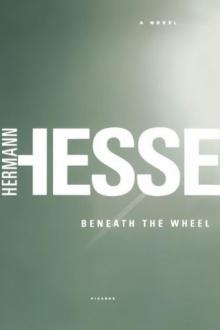 Beneath the Wheel
Beneath the Wheel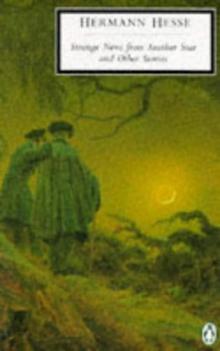 Strange News From Another Star
Strange News From Another Star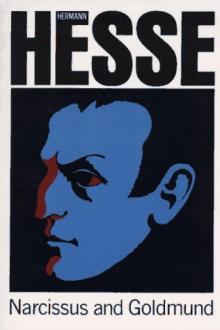 Narcissus and Goldmund
Narcissus and Goldmund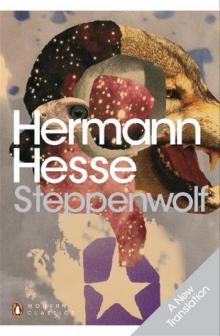 Steppenwolf
Steppenwolf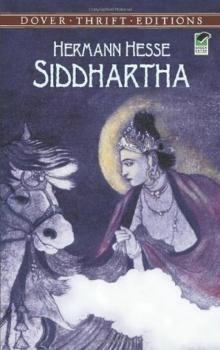 Siddhartha
Siddhartha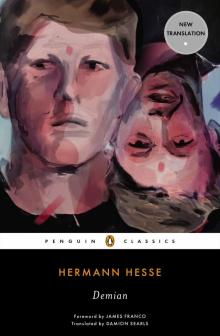 Demian
Demian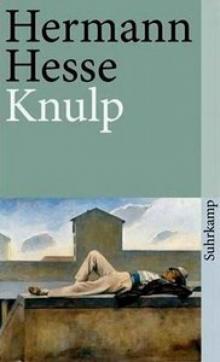 Knulp
Knulp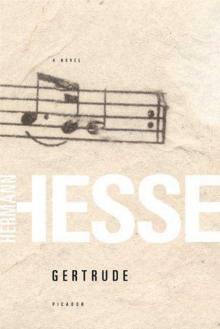 Gertrude
Gertrude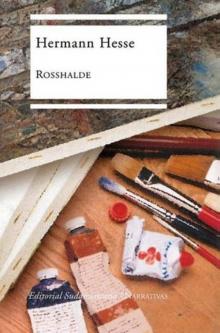 Rosshalde
Rosshalde The Glass Bead Game
The Glass Bead Game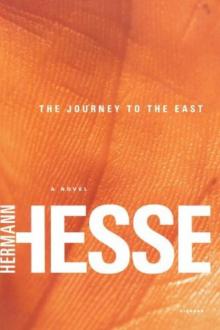 The Journey to the East
The Journey to the East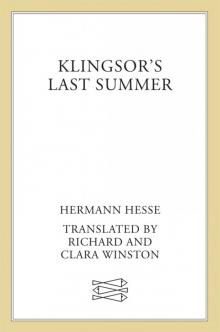 Klingsor's Last Summer
Klingsor's Last Summer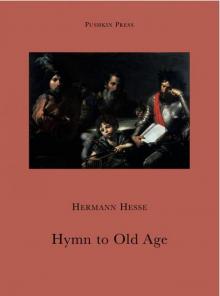 Hymn to Old Age
Hymn to Old Age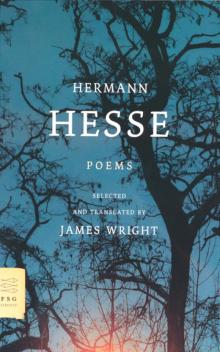 Poems
Poems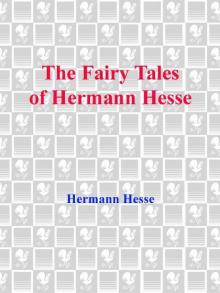 The Fairy Tales of Hermann Hesse
The Fairy Tales of Hermann Hesse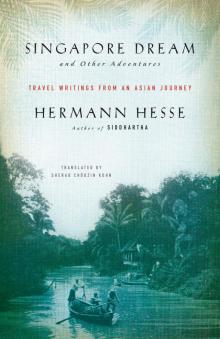 Singapore Dream and Other Adventures
Singapore Dream and Other Adventures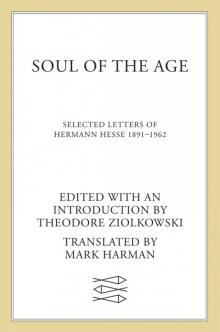 Soul of the Age
Soul of the Age